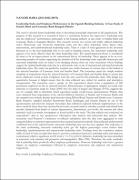| dc.description.abstract | NANZIRI MARIA (2011-M102-20075)
Leadership Styles and Employee Performance in the Uganda Banking Industry. A Case Study of Stanbic Bank and Centenary Bank Kampala District
The need to develop better leadership styles is becoming increasingly important in all organisations. The purpose of this research is to ascertain if there is a correlation between the supervisor’s leadership style and the employees‟ performance, particularly in the banking industry (a case study of Stanbic Bank and Centenary Bank in Kampala District). This research reviews two recent and widely utilised leadership styles: Democratic and Autocratic leadership styles and also other leadership styles; laissez faire, transactional, and transformational leadership styles. There is a lack of total agreement in the reviewed literature as to the best leadership style to be used in banking sectors, but Autocratic leadership style appears to be more effective than the other leadership styles. The transformational theory is considered by many to be an improvement on the transactional theory of leadership. There appears to be an ever-increasing number of studies supporting the benefits of all the leadership styles especially democratic and autocratic leadership styles. In today’s ever-changing climate, there are some researchers whose findings suggest the optimal leadership style may be a democratic style or any of transactional and transformational leadership styles. The study was guided by research case studies because of various traits of the leaders in the selected branches of Centenary bank and Stanbic Bank. The researcher opted for simple random sampling of respondents from the selected branches of Centenary Bank and Stanbic Bank to ensure that those employees found at their workplaces were the ones used for this particular study. This design was quantitative because it helped ensure that the data collected was critical for analysis and descriptive interpretation. The researcher used a sample of 144 respondents drawn from a population of 286 permanent employees in the six selected branches. Determination of appropriate samples was made with reference to assertions made by Amin (2005) who (by help of kregcie and Morgan (1970)), suggests the use of a sample table to determine which equivalent sample would ensure representation. Primary data were obtained from respondents at the selected different branches of Stanbic and Centenary Banks and the sampled ones include: Stanbic bank branches along Wilson Road, Nateete and Ntinda town. Centenary Bank branches sampled included Namirembe Road, Kabalagala and Nateete Branch by use of the questionnaires and interview manuals. Secondary data collection explored methods supplementary to the above method where data were obtained from books, research made by scholars, journals and related bank records (obtained from heads of various departments), dissertations, text books, the internet and other materials (such as journals, newspapers) as found useful to the study. The data analysis was conducted on respondents‟ data in two perspectives: Descriptive data analysis and inferential data analysis. The researcher used Pearson‟s correlation co-efficient calculation after the data were aggregated to turn categorical data to numerical representation that required numerical methods. Data collected and presented confirmed that in the selected banks, autocratic leadership style was the most applied. The responses to the traits symbolising autocratic leadership styles got the highest percentages verses Laissez faire leadership, transformational and transactional leadership styles. Findings from the correlation analysis (table 4.8 and 4.9) also revealed that there is a positive correlation between Leadership styles and employee commitment which is significant at 0.01 level (r = 0.733, p≤0.01). Directive leadership has been described as autocratic, task-oriented, and persuasive and manipulative (Bass 1981). Therefore, the study concludes that Leadership Styles positively affect employee performance. However, leadership styles have a greater impact on employee commitment followed by employee motivation and employee job satisfaction respectively.
Key words: Leadership, Employee, Performance, Bank | en_US |


